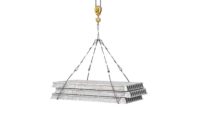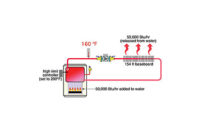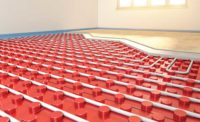Anyone who has installed hydronic floor heating surely has watched as their neatly placed tubing circuits get buried in concrete.
Sometimes the tubing and reinforcing mesh gets lifted into the thickness of the slab as the concrete is placed. Other times the masons trample over the tubing and mesh as if it’s not even there. Any instructions given to them by the radiant installer seem to vanish as the concrete begins flowing down the chute.
Unlike relocating a sensor or unthreading a pipe fitting, there’s no way to change tubing depth once the concrete is placed. The thermal performance of the slab with its embedded tubing now is fixed for the life of the building.
The irreversibility of the situation should make us question if we’re installing the tubing in the best manner possible. If the depth of the tubing doesn’t have much of an effect on performance why worry about it? On the other hand, if depth does have a substantial effect on performance why be ignorant of it? Why sacrifice performance to a detail that adds very little if any to the cost of the system?
There are several ways tubing depth should theoretically affect the performance of a heated slab.
- The deeper the tubing is the greater the thermal resistance between it and the slab surface. The higher the thermal resistance, the higher the water temperature required to maintain a given rate of heat transfer.
- The closer the tubing is to the bottom of the slab the greater the underside heat losses should be. This is true with or without underslab insulation. Thermal losses are obviously greater in the latter case.
- When the tubing ends up near the bottom of the slab more of the slab’s thermal mass is above the level where heat is being added. This lengthens the time it takes to warm the floor surface to normal temperatures following a call for heat.
It also lengthens the cool-down time after heat input is interrupted by system controls. A fully charged slab can hold several hours-worth of heat that will continue to flow into the space as long as the air temperature and/or interior surface temperatures are cooler than the floor surface. This can be a real problem in buildings with significant internal heat gains from sunlight or other sources, especially when those gains follow a cold night in which significant heat was added to the slab.
Considering these issues it seems obvious that placing tubing higher in the slab will improve its performance. The harder questions are:
- How much is performance affected by tubing depth?
- Is the change in performance worth a few well-chosen words with a disinterested mason?
Slab simulations
To get a handle on the tube depth issue I turned to a specialized technique called finite element analysis (or FEA for short). FEA software allows one to build a model of the situation you want to test, run it and then see what the temperature would be at any point you’re interested in. The calculations this software does in a couple seconds would take years to complete by hand.
One of the models I constructed is shown in Figure 1. It consists of a 4-in. concrete slab sitting on 1-in. (R-5) polystyrene insulation and covered by 3/8-in. oak flooring.
Several versions of this model are used to simulate tubing at different depths in the slab. Each time the model is run it determines the temperature at hundreds of points within a small region of the slab including points spaced 1/2-in.apart along the floor surface.
The curves in Figure 2 show the predicted surface temperature profiles for the model of Figure 1. They indicate the following things happen as the tubing is placed deeper in the slab.
- The floor surface temperature directly above the tube decreases due to the greater R-value between the tube and the surface.
- The difference between the floor surface temperature directly over the tube and that halfway between adjacent tubes decreases. This is a desirable effect that makes it harder to feel where the tubing is located under the floor.
- The area under each surface temperature profile is different. This area is proportional to upward heat output.
Using the temperature data from several runs of the FEA software I estimated the heat output from the system for water temperatures of 100° F and 130° F. For both water temperatures, heat output increases as the tubing is lowered through the upper portion of the slab and then drops off as the tubing gets deeper. This means there’s an optimal tube depth where the slab delivers maximum heat output. The simulations I ran suggest it’s about 1/4 of the slab thickness down from the slab surface. This depth could vary depending on flooring resistance and other factors.
I also used the FEA results to determine the average water temperatures required to deliver heat outputs of 15 and 30 Btu/hr./ft2. The results are shown in Figure 3.
Notice that the average circuit water temperature required to deliver 30 Btu/hr./ft2 is 14° F higher when the tubing is at the bottom of the slab vs. centered in the slab thickness.
Can the system’s boiler provide the higher water temperatures required by the deeper tubing? Sure it can. If it happens to be a conventional boiler the effect on efficiency for operating the circuit 14° F higher is probably quite small.
But what if the heat source is a mod/con boiler or geothermal heat pump? The increased water temperature required to deliver the same rate of heat output lowers the condensing potential of the boiler and deceases the COP (efficiency) of the heat pump. Higher water temperatures also mean reduced capacity through mixing devices, higher heat loss from distribution piping and higher downward heat loss from the slab. These all are undesirable.
Running bare
I also used the FEA software to simulate how tubing depth effects heat output for slabs without any finish flooring. A graph showing upward heat output vs. tubing depth for a 4-in. thick bare concrete slab is shown in Figure 4.
The results again show that heat output drops off as tubing depth increases. The highest output for the cases I ran occurs when the tube is centered about 3/4-in. below to the slab surface (about 25 Btu/hr./ft2 at 100° F water temperature). Lowering the tube another inch into the slab reduces output to 24 Btu/hr./ft2. Taking it down yet another inch lowers the output to 22.3 Btu/hr./ft2. These changes are relatively small.
However, look what the model predicts when the tube is located at the bottom of the slab. Here the output is only 16.6 Btu/hr./ft2, about 31% lower than when the tube is centered 2” below the surface. The slab with the bottomed-out tubing needs 115° F water to yield an output of 25 Btu/hr./ft2 compared to only 101° F water temperature if the tubing was centered 2 in. below the surface.
Up here, down there
Of course there are factors other than thermal performance that have a bearing on tubing depth. One is protecting the tubing near sawn control joints. The depth of such saw cuts typically is 20% of the slab thickness. I prefer to keep the tubing near the bottom of the slab at such locations to give the blade a wide berth as it passes over. A typical detail is shown in Figure 5.
Another consideration is penetrations by fasteners used to secure equipment to the slab.
In most cases it doesn’t make sense to leave all the tubing at the bottom of the slab just to accommodate what might be a future bench or lift post. Find out where this equipment will be placed and keep the tubing a couple feet away from where the fasteners are located. Block out and note these areas on your tubing layout drawing. Be sure to leave a copy of the plan with the owner.
The takeaways
Although FEA simulation is a theoretical approach, the results obtained agreed fairly well with other published models for upward heat output.
The predicted increase in water temperature required for tubing at the bottom (rather than the center) of the slab is both believable and significant.
A nominal 10% increase in downward heat loss caused by higher water temperatures in bottomed-out tubing also was predicted.
Also keep in mind these results are based on steady-state simulation. They don’t predict the consequences of the longer response times associated with deeper tubing. Mix strong internal heat gains into such a situation and you’ve got the potential for significant overheating.
Considering the degraded thermal performance of tubing at the bottom of slabs I feel it’s imperative to ensure tubing is placed at the proper depth. For starters be sure this is clearly shown on plans and written into specifications.
Follow up by discussing the importance of the tube depth detail with those responsible for concrete placement.











